Consumer Decision Journey
Mit Consumer Decision Journey (CDJ) wird ein Modell bezeichnet, das beschreibt, wie Konsumenten Kaufentscheidungen treffen. Die Consumer Decision Journey ist demnach nicht-linear. Das bedeutet, dass die Phasen bis zur finalen Kaufentscheidung nicht nacheinander ablaufen, sondern sich oft überschneiden und wiederholen. Die CDJ hebt insbesondere die Bedeutung des Empfehlungsmarketings hervor, indem es Faktoren wie Kundenloyalität, Kundenbindung und die Erfahrungen nach dem Kauf mit in das Modell einbezieht (Vergleich Post-Conversion Marketing ).

Inhaltsverzeichnis
- 1 Allgemeine Informationen zum Thema
- 2 Consumer Decision Journey
- 3 Bedeutung für das Online Marketing
- 4 Einzelnachweise
Allgemeine Informationen zum Thema
Der traditionelle Ansatz bei der Beschreibung des Kaufverhaltens beinhaltet vier Phasen. Eine zentrale Annahme dabei ist der sogenannte Purchase oder Conversion Funnel : Mithilfe eines Trichters wird versucht, der Weg des Kunden theoretisch nachzuzeichnen und herauszufinden, wo der Kunde mit dem Unternehmen in Kontakt tritt (sogenannte Touch Points ).
- Erstkontakt: Der Konsument beginnt mit einer bestimmten Anzahl von Marken, auf die er durch Werbung oder Empfehlungen von Freunden und Bekannten aufmerksam geworden ist.
- Auswahl: Er reduziert die Anzahl der Marken, indem er bestimmte Merkmale des Produktes oder der potenziellen Marken auswählt und eingrenzt.
- Vergleich: Er wägt ab und vergleicht.
- Kauf: Er entscheidet sich für eine Marke und somit für ein Produkt.
Dieser Verkaufstrichter oder Funnel ist die Ausgangslage für das neuere Modell der Customer Decision Journey. Denn die Gegebenheiten, die während eines Kaufprozesses eine Rolle spielen, ändern sich in einem ähnlichen Tempo wie technologische Entwicklungen. Konsumenten haben heutzutage zahlreiche Möglichkeiten, um mit einer Marke in Kontakt zu treten – inklusive mobile Endgeräte. Das traditionelle Modell kann diese Touch Points, die zu Kaufentscheidungen führen, nicht adäquat abbilden. Hinzu kommt, dass nur ein Bruchteil der Konsumenten den Kaufprozess in einer Sitzung abschließt. Viele Käufe kommen erst nach etwa zwei Wochen zustande, wenn Konsumenten eine Website wieder besuchen. [1]
Das Consulting Unternehmen McKinsey führte 2009 eine Studie mit über 20.000 Teilnehmern aus verschiedenen Branchen und drei Ländern durch. Die Erkenntnisse dieser Studie bilden die Basis für das CDJ-Modell. [2]
Es besteht aus folgenden Phasen:
- Consideration : Der Konsument startet mit einem Set aus durchschnittlich drei bis vier Marken oder Unternehmen, wenn er nicht bereits ein loyaler Kunde eines Unternehmens ist.
- Evaluation : Nun bewertet er die Marken, die er im Blick hat. Bereits hier wird ein wesentlicher Unterschied zum Funnel deutlich. Der Konsument kann auf eine Vielzahl an digitalen Kanälen zurückgreifen, um sich zu informieren. Suchmaschinen , soziale Netzwerke und Blogs dienen ihm neben weiteren Ressourcen als Informationsquelle. An diesen unterschiedlichen Touch Points oder sogenannten Micro-Conversions können Unternehmen ihre Kunden abholen.
- Buy : Wenn der Konsument sein Bedürfnis befriedigt sieht, tätigt er einen Kauf. An diesem Touch Point sollten die Barrieren so klein wie möglich sein, sodass der Konsument mit möglichst wenig Klicks einen Kauf abschließen kann.
- Experience, Advocate & Bond : Diese Phasen beschreiben, was nach dem Kauf geschieht. Der Konsument benutzt das Produkt und sammelt Erfahrungen. Sind diese positiv, gibt er womöglich eine Bewertung ab und empfiehlt das Produkt weiter. Das Word-of-Mouth-Marketing nimmt bei der CDJ eine zentrale Stellung ein, da dieses Feedback sich auf die Phase der Evaluation auswirkt. Es entsteht eine Schleife. Negatives Feedback beeinflusst die Kaufentscheidungen von anderen Konsumenten; es kann aber auch als Verbesserungsvorschlag für zukünftige Unternehmungen sein. Wenn die Erfahrungen, die ein Konsument mit einem Unternehmen gesammelt hat, durchweg positiv waren, kann es dazu kommen, dass er ein loyaler Kunde wird. Dabei gibt es zwei Arten von Loyalität. Die eine bezieht sich auf Loyalitäts-Programme, die zum Beispiel besondere Angebote beinhalten. Die andere Art konzentriert sich auf das Management der Kundenbeziehungen und die Erfahrungen, die ein Konsument mit einem Unternehmen sammelt. Dazu gehören auch Kontakte mit dem Kundendienst oder Konversationen in verschiedenen sozialen Netzwerken.
Bedeutung für das Online Marketing
Das Modell der Consumer Decision Journey versucht die Komplexität eines Kaufprozesses abzubilden und erweitert das traditionelle Modell um einige wesentliche Punkte. Insbesondere das Hinzufügen von unterschiedlichen Touch Points und Feedback-Schleifen ist hier zu nennen. Viele Konsumenten kaufen Produkte mittlerweile mit einem mobilen Endgerät und interagieren mit Marken auf unterschiedliche Weise. Das CDJ-Modell unterstreicht die Bedeutung einer Kommunikation, die in beide Richtungen und über unterschiedliche Geräte abläuft. Dabei werden Touch Points anvisiert, die einen erheblichen Einfluss auf die Kaufentscheidung haben und somit auch aus monetären Gesichtspunkt relevant erscheinen. [3]
Zudem spielen Bewertungen, Empfehlungen und Testberichte eine immer größere Rolle beim Kaufprozess. Eine der wichtigsten Erkenntnisse des CDJ-Modells besteht darin, dass die Pflege der Kundenbeziehung nach dem Kauf nicht stoppen sollte. Vielmehr gilt es, die Customer Experience auch in den Phasen nach dem Kauf positiv zu gestalten. Denn der Konsument kann als Influencer fungieren, indem er ein Produkt bewertet. Er trägt das positive Image einer Marke oder eines Produktes weiter und wird im günstigsten Fall ein Marken-Advokat – ein loyaler Kunde, der durch seine Empfehlungen Werbung macht.
Einzelnachweise
- ↑ DoubleClick Releases Q1 2004 E-Commerce Site Trend Report. thefreelibrary.com. Abgerufen am 20.07.2015
- ↑ The consumer decision journey mckinsey.com. Abgerufen am 20.07.2015
- ↑ Your customer’s purchase journey has changed – has your marketing? smartinsights.com. Abgerufen am 20.07.2015
- Infografik Customer Decision Journey
- Digitizing the consumer decision journey
- Branding im digitalen Zeitalter
- Online Marketing
- Suchmaschinenwerbung (SEA)
- Suchmaschinenoptimierung (SEO)
- Social Media Marketing
Customer Journey

Philippe Großmann
· Aktualisiert am 15.12.2022
Es ist nicht immer ganz so einfach, eine gewisse Kundennähe zu schaffen. Somit stellt sich die Frage: Wie kann man diese am besten erreichen? Eine Entwicklung der Customer Journey kann hier die Antwort auf die Frage sein. Was genau dahinter steckt, erklären wir Ihnen in diesem Beitrag.
Inhaltsverzeichnis
Was ist eine customer journey, warum ist eine customer journey wichtig, touchpoints einer customer journey, was muss man beachten, customer journey modell von aufgesang, weitere customer journey modelle, das messy-middle-modell, aida modell, consumer decision journey, moments of truth modell, die customer- purchase-journey, ziele der customer journey, vorteile einer customer journey, die grenzen des customer journey modells.
Customer Journey (Kundenreise, Users oder Buyers Journey) bezeichnet eine Online-Marketing-Strategie, wobei einzelne Phasen von potenziellen Kund:innen durchlaufen werden, bevor sie sich für einen Kauf von Produkten oder Dienstleistungen entscheiden.
Eine Customer Journey Map sorgt für eine bessere Übersicht und zeigt alle Schritte an, die Kund:innen während ihrer Beziehung zu einem Produkt, einer Marke oder einer Dienstleistung unternehmen. Der Prozess ist darauf ausgelegt, Kund:innen vom ersten Eindruck bis zur endgültigen Conversion den Weg vorzugeben/zu zeigen und sie zielführend durch die gesamte Nutzererfahrung zu leiten. Dadurch soll sichergestellt werden, dass Kund:innen immer auf dem richtigen Weg sind und sich unterwegs nicht verirren. Das Erstellen einer Customer Journey erfordert viel Zeit und Energie. Manchmal kann eine Customer Journey von Minuten über Wochen bis hin zu Monaten dauern. Dies liegt daran, dass es Hunderte von Berührungspunkten auf einer einzigen Reise gibt. Nach der Fertigstellung bietet es Unternehmen einen aussagekräftigen Einblick in die Bedürfnisse und das Verhalten ihrer Kund:innen und dient somit als Grundlage für mögliche Optimierungsmaßnahmen.
Phasen einer Customer Journey: Pre-Awareness -> Awareness -> Consideration -> Preference -> Purchase -> After-Sale -> Loyalty
Eine Customer Journey bietet Lösungen und Optimierungen im Bereich des Online Marketings und stellt die Kundenbedürfnisse transparent dar.In erster Linie dient es zur Identifizierung von Touchpoints, um die Kundenreise zu einem positiven Erlebnis zu machen. Eine optimale Lösung, um das Geschäftswachstum zu beschleunigen und die Kundenabwanderung zu reduzieren. Von Anfang bis Ende können Sie erkunden und verstehen, wie Ihre Kund:innen Ihr Unternehmen und Ihre Marke erleben. Interaktionen helfen dabei, potenzielle Kund:innen mit positiven Emotionen zu verbinden, indem sie Ihre Kund:innen während der gesamten Customer Journey personalisieren. Customer Journeys helfen Ihnen unter anderem bei der Feinabstimmung und Verbesserung Ihrer Online-Kampagnen.
In der Customer Journey haben Kund:innen mehrere kleine Berührungspunkte mit Produkten, Dienstleistungen, einer Marke oder Personen. Diese Berührungspunkte werden auch Touchpoints genannt. Sie umfassen zahlreiche Werbemöglichkeiten, sind aber auch organische Berührungspunkte sowohl in analogen als auch in digitalen Umgebungen. Neben Conversions und Käufen ist es wichtig, Kundennähe und Loyalität aufzubauen. Unternehmen sollten daher die Initiative ergreifen, ihre Kund:innen regelmäßig zu kontaktieren. Ziel ist die Kundenzufriedenheit bei jedem Schritt.
Neben den gängigen Online-Tools werden für die Ermittlung der Touchpoints zusätzlich verschiedene Marktforschungsinstrumente verwendet:
Social Media
Suchmaschinenoptimierung und -werbung
E-Mail-Marketing (Newsletter)
Influencer:innen
Messen und Events
klassische Werbung (Print, TV und Rundfunk)
persönliche Empfehlungen durch Familie, Freunde und Bekannte
Die Identifizierung von “typischen Kund:innen” (Buyer Persona) hilft bei der Bestimmung, welche typischen Käufer:innen Sie repräsentieren möchten. Sobald Sie Käufer:innen im Auge haben, bestimmen Sie, wie diese während der Customer Journey eine Verbindung zu Ihrer Marke oder Ihrem Unternehmen herstellen.
Folgende Fragen sollten Sie sich stellen:
Welche Maßnahmen können Sie ergreifen, um sicherzustellen, dass dieser Kunde loyal bleibt?
Über welche Kanäle können Sie ihn kontaktieren?
Welche Art von Botschaften schätzen die Kunden am ehesten?
Das Erstellen einer Customer Journey Map ist vorteilhaft, um den Kund:innen bei dieser Art des Denkens an die erste Stelle zu setzen.
Unternehmen können ihren Kund:innen die Reise erleichtern, indem sie eine Vielzahl von Methoden verwenden, einschließlich CRM-Systemen (Customer Relationship Management).
Mittlerweile wurden zu den klassischen Modellen neue Ansätze hinzugefügt, denn bei einer Customer Journey wird eigentlich zwischen User Journey und Customer Journey unterschieden. Dies wird in dem Modell von Aufgesang deutlich.
Es bedeutet, dass die Leute also schon weit vor einem Kauf mit dem Produkt in Kontakt treten. Zu dem Zeitpunkt ist derjenige noch ein “User”. Ab der Purchase-Phase werden die Nutzer:innen zu Kund:innen, da sie dort eine Tat ausführen wollen, sprich das Produkt kaufen wollen.
Pre-Awareness: Nutzer:in hat konkretes Interesse an ein Produkt
Awareness: Nutzer:in zeigt Interesse an Themen im Umfeld
Consideration: Nutzer:in hat Interesse an möglichen Lösungen im Umfeld des Angebotes
Preference: Nutzer:in möchte etwas aus dem Portfolio kaufen und sucht einen Anbieter
Purchase: Kund:in möchte etwas kaufen/beauftragen
After-Sale: Kund:in hat das etwas gekauft/beauftragt und macht erste Erfahrungen
Loyalty: Kund:in ist schon länger zufrieden
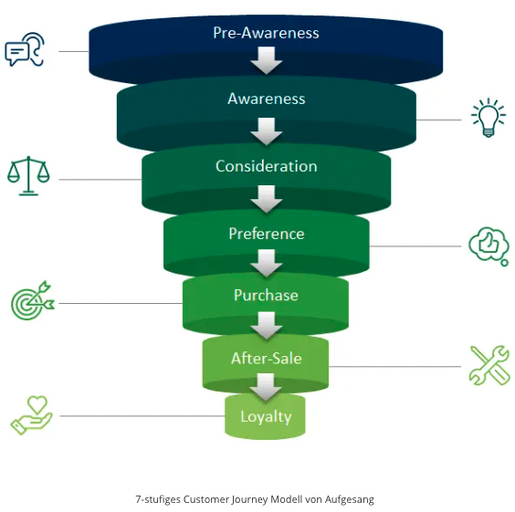
Für die Darstellung einer Kundenreise gibt es neben dem Aufgesang-Modell noch andere, die sich bewährt haben und die wir im Folgenden kurz vorstellen.
Das Messy-Middle-Konzept geht davon aus, dass sich die Nutzer:innen noch in einem Zustand der Erkundung und Bewertung befinden, bevor eine Kaufentscheidung getätigt wird. Nutzer:innen folgen oft einer bestimmten Reihenfolge, wenn sie nach Lösungen, Produkten und Angeboten suchen. Je nachdem, in welcher Phase sich die Nutzer:innen Informationen einholen möchten, wollen sie im Anschluss Lösungen vorliegen haben und schließlich konkrete Produkte vorgestellt bekommen. Trigger sorgen dafür, dass Nutzer:innen Research-Prozesse initiieren, die je nach Verständnis Grad an unterschiedlichen Stellen der Customer Journey angestoßen werden können. Google nennt diesen Vorgang Messy Mediation und beschreibt ihn als Wechsel zwischen Discovery und Pre-Purchase Evaluation.
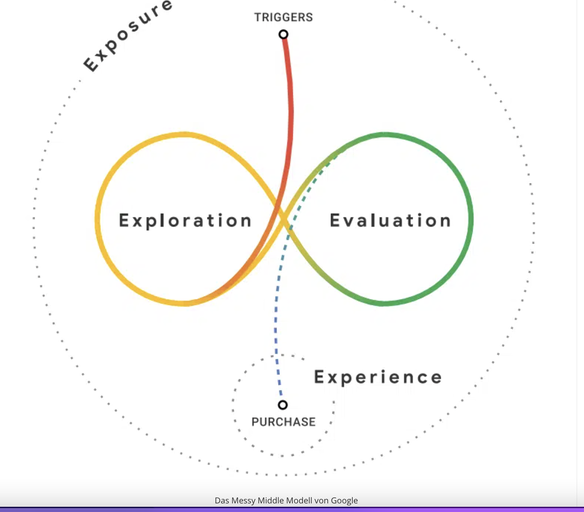
Bestimmt haben Sie schon einmal von dem AIDA Modell gehört. Dieses ist weit verbreitet und wird auch für andere Dinge verwendet.
Der Kunde wird auf das Produkt aufmerksam, interessiert sich aktiv dafür, generiert ein Bedürfnis und schließt im Idealfall den Kauf ab. Die sprichwörtliche Trichterform taucht im Modell auf, da einige Kunden während des Prozesses immer wieder abgesetzt werden.
Das AIDA Modell ist in folgenden Kategorien aufgebaut:
Attention - Orientierung und Informationsfindung (Recherche von Informationen)
Interest - Analyse und Anforderungsphase (Bedarf vertiefen und konkretisieren)
Desire - Lösung & Anbieter finden (Informationen auf Webseiten verglichen)
Action - Kontakt zum Anbieter aufnehmen

Das Modell wurde von McKinsey erstellt. Dieses Modell ist kein Funnel wie das AIDA-Modell, es beginnt mit der Überlegungsphase und endet mit der Kaufphase, es hat nur zwei Phasen und stellt nur einen Teil der Customer Journey dar. Nutzer:innen haben Bedürfnisse und suchen nach möglichen Lösungen, um diese Bedürfnisse zu erfüllen. Nutzer:innen organisieren ihre Optionen in ihren Gedanken und analysieren, welche Lösungen ihnen am besten gefallen. Letztendlich entscheiden sich die Nutzer:innen für den Kauf einer bestimmten Lösung. Dadurch werden Nutzer:innen zu Kund:innen.

Procter & Gamble entwickelte eines der bekanntesten Customer Journey Modelle - das Moments of Truth Modell. Der Begriff ist aus dem Marketing nicht mehr wegzudenken. Diese verschiedenen “Momente der Wahrheit” haben die folgenden Implikationen:
Der First Moment of Truth (FMOT), geprägt von Alan George Lafley (Procter & Gamble) im Jahr 2005, repräsentiert den Moment, in dem Verbraucher:innen auf ein Produkt im Regal aufmerksam werden.
Der Second Moment of Truth (SMOT) ist gekennzeichnet, wenn Verbraucher:innen nach dem Kauf eines Produkts ein Qualitätsversprechen akzeptieren.
Der 2006 vom Digital- und Social-Media-Experten Pete Blackshaw (Procter & Gamble) vorgeschlagene Third Moment of Truth (TMOT) ist eine Möglichkeit für Verbraucher:innen, ein Produkt basierend auf ihrer Erfahrung als positiv, neutral oder negativ zu bewerten. Dies kann entweder durch direkten Kontakt mit anderen Verbraucher:innen oder indirekt geschehen. Diese Merkmale spielen im heutigen Online-Marketing eine entscheidende Rolle.
Zero Moment of Truth (ZMOT) bezieht sich auf die Situation, in der potenzielle Kund:innen beginnen, im Internet nach einem Produkt oder einer Dienstleistung zu suchen. Im Internet werden weitere Informationen gesucht, welche durch die Stimmlust der Kund:innen geleitet werden. Mit zunehmender Nutzung mobiler Endgeräte wie Smartphones und Tablets nähert sich dieses Verhalten dem Point of Purchase.
2013 wurde von dem Analysten Brian Solis der Altimeter Group der Ultimate Moment of Truth (UMOT) konzipiert. UMOT ist, wenn in den sozialen Medien die Produkterfahrungen der Verbraucher:innen geteilt werden. Dies ist für den Zero Moment of Truth eine wichtige Grundlage. UMOT hat eine wichtige Funktion, es stellt nicht nur aktive Inhalte, sondern auch die Wirksamkeit dieser Inhalte für die einzelnen Internet-Mechanismen, wie Relevanz und Auffindbarkeit dar.

Die Customer-Purchase-Journey kombiniert das von Aldo Kondari erstellte Moment-of-Truth-Modell mit dem Decision-Journey-Modell und unterteilt die Journey in Awareness, Consideration, Evaluation, Purchase und Experience.
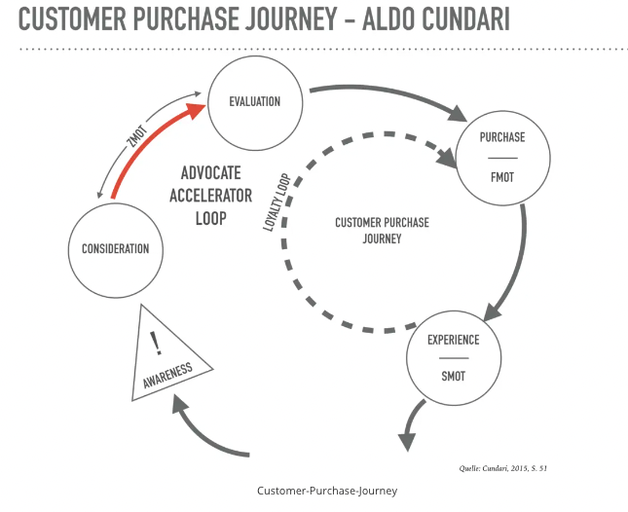
Wenn Sie die Gewohnheiten und Motivationen der Kund:innen während ihrer gesamten Reise verstehen, können Sie die Vorlieben und Gewohnheiten besser nachvollziehen. Indem Sie Ihre gesamte Erfahrung verfolgen, können Sie mehr als nur die Bedürfnisse Ihrer Kund:innen an jedem Stopp auf dem Weg erfüllen. Dies führt zu effektiveren Lösungen, als einfach nur das bereitzustellen, was sie wollen. Geben Sie Ihren Kund:innen immer genau das, was sie brauchen - über den richtigen Kanal zur richtigen Zeit. Indem Sie die individuellen Wege Ihrer Kund:innen hinterfragen, werden Sie potenzielle Möglichkeiten entdecken, den Service zu verbessern und den Umsatz nachhaltig zu steigern. Um ein ganzheitliches und zufriedenstellendes Kundenerlebnis zu schaffen, müssen neue Ideen in Ihr Kommunikationskonzept übertragen werden. Nur so entsteht ein ganzheitlicher Ansatz für alle Aspekte des Jobs.
Die Kundenreise wird durch die Zusammenarbeit von Public Relations, Marketing und Werbung optimiert. Bei einer Customer Journey ist es zudem von Vorteil, dass ein Unternehmen neue Kund:innen durch die genaue Planung der Vorgehensweise gewinnen kann. Durch die Touchpoints können Veränderungen rechtzeitig wahrgenommen und somit schnellstmöglich behandelt werden. Die gezielte Optimierung ist bei einem Prozess der Customer Journey sehr wichtig, dadurch können Veränderungen besser beurteilt werden. Des Weiteren können Unternehmen ein besseres Verständnis zu ihrer Kundschaft entwickeln, da sie durch die Customer Journey genaue Einblicke in die Verhaltensmuster erhalten.
Natürlich hat das Customer-Journey-Modell auch seine Schwächen. Diese hängen oft mit der Komplexität der Customer Journey zusammen. Nicht immer sind alle vorhandenen Datenverknüpfungen und Touchpoints eindeutig oder erkennbar. Die Kundenzufriedenheit ist Beispielsweise ein Schlüsselelement, welches man in jedem Fall berücksichtigen muss. Eine solche Anfrage ist jedoch manchmal nicht einfach und basiert auch nicht auf einem konkreten Kontakt zwischen Kund:innen und dem Unternehmen oder der Marke. Erschwerend kommt hinzu, dass immer mehr Nutzer:innen auf den Datenschutz aufmerksam werden und die Verarbeitung oder Nutzung ihrer Daten kritisieren. Trotz allem ist eine Customer Journey oder Customer Journey Map mehr als nur ein wertvolles Tool für Ihre Online-Marketing-Strategie und wird in dieser Form mit Sicherheit noch eine Weile bestehen.
Hinter dem Begriff “Customer Journey” steckt mehr, als man denken würde. Die Kundenreise hilft bei der Entwicklung des Verständnis und für das Verhalten der Kund:innen. Der Kaufprozess der Kund:innen wird analysiert und bewertet. Die Einteilung ist in mehrere Phasen unterteilt und dient zur planvollen Vorgehensweise und zur Optimierung der potenziellen Zielgruppen. Die Informationen werden gleichzeitig am richtigen Ort (Touchpoints) zur passenden Zeit zur Verfügung gestellt. Durch die vielen Vorteile sollte eine Customer Journey somit in jedem Unternehmen berücksichtigt werden.
Jetzt Newsletter abonnieren.
Erhalten Sie exklusive & kuratierte Inhalte direkt in Ihren Posteingang.

Philippe entwickelt Online Marketing Kampagnen, ist Web-Analytics Enthusiast und ein großer Fan von PPC-Marketing.
Root out friction in every digital experience, super-charge conversion rates, and optimize digital self-service
Uncover insights from any interaction, deliver AI-powered agent coaching, and reduce cost to serve
Increase revenue and loyalty with real-time insights and recommendations delivered to teams on the ground
Know how your people feel and empower managers to improve employee engagement, productivity, and retention
Take action in the moments that matter most along the employee journey and drive bottom line growth
Whatever they’re are saying, wherever they’re saying it, know exactly what’s going on with your people
Get faster, richer insights with qual and quant tools that make powerful market research available to everyone
Run concept tests, pricing studies, prototyping + more with fast, powerful studies designed by UX research experts
Track your brand performance 24/7 and act quickly to respond to opportunities and challenges in your market
Explore the platform powering Experience Management
- Free Account
- For Digital
- For Customer Care
- For Human Resources
- For Researchers
- Financial Services
- All Industries
Popular Use Cases
- Customer Experience
- Employee Experience
- Employee Exit Interviews
- Net Promoter Score
- Voice of Customer
- Customer Success Hub
- Product Documentation
- Training & Certification
- XM Institute
- Popular Resources
- Customer Stories
- Market Research
- Artificial Intelligence
- Partnerships
- Marketplace
The annual gathering of the experience leaders at the world’s iconic brands building breakthrough business results, live in Salt Lake City.
- English/AU & NZ
- Español/Europa
- Español/América Latina
- Português Brasileiro
- REQUEST DEMO
- Experience Management
- Customer Journey Mapping
- Consumer Decision Journey
See how XM for Customer Frontlines works
The consumer decision journey.
14 min read Understanding the consumer decision journey – and working with what you learn – can help your marketing efforts, customer support teams, and product rollouts thrive. Here’s everything you need to know…
Author: Adam Bunker
Subject Matter Expert: Dave Pabley
What is the consumer decision journey?
The ‘consumer decision journey’ is the name given to a framework that deconstructs and explores the myriad factors that go into customer purchases. In other words: it’s the way we make sense of the consumer decision-making process.
Did you know that 70% of buyers fully define their own purchasing needs before they engage with sales people? If not, you might need to rethink what your customer decision journeys look like, and how you work to manage them.
Every time a customer buys something from a brand, it’s the result of a complicated set of processes and influences that – often – they’ve experienced in a nonlinear fashion. The consumer decision journey is a means to map and understand that path, with a view to try and meet potential future customers at every touchpoint along the way.
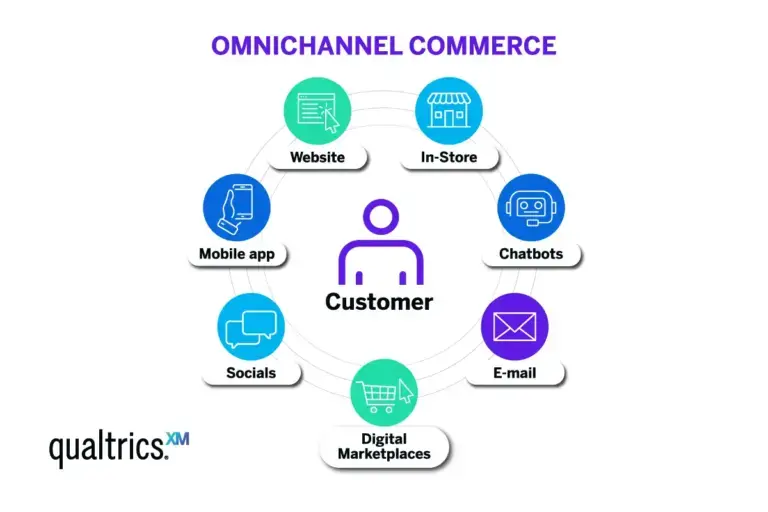
Understanding how and why new and previous customers make purchases is the holy grail of every marketing department in the world. And if you can actually influence those factors with your CX and marketing strategy? Even better. Doing that means unpicking the complicated rationale and stop-start nature of today’s buying journeys.
Understanding the consumer decision journey is really about asking a few key questions:
- How can you meet your customers at important touchpoints?
- How can you maximize each interaction?
- What goes into each purchase decision?
If you have answers to those questions, you’ll go a long way toward ensuring you have the right processes, resources, and technology in place to help your business grow its customer base. You’ll know how and when to upsell, how to convert prospects, and what influences each and every purchase.
That’s a complicated task, but digging into customer analysis can really pay off – in some pretty meaningful ways.
Free course: Elevate your customer journey management today
‘Customer managed’ journey versus a ‘managed customer’ journey
Today’s customer is increasingly empowered in their decision-making, since they have access to much more choice, information, and branded content across a range of channels.
As such, it’s important that brands understand their role in the decision-making process. In most instances, things can’t be controlled in a streamlined way on the brand side – it’s the customer in control. That means organizations need to be adaptable, responsive, and able to meet the customer where they are, rather than the other way round.
While you might map out a perfect, best-case journey for your customer personas – a managed customer journey – things may not pan out that way. This gives rise to the idea of the ‘customer managed’ journey instead – one where your customers call the shots in terms of how they make their decisions, and you cater as best you can to their preferences.
Why is the consumer decision journey important?
Customer interactions and the journeys they create are more complicated, nonlinear, and omnichannel than ever. But that presents an opportunity: the brands that can leverage the tools at their disposal to unpick that complicated knot stand a great chance at winning over more customers than their competitors.
Today’s customers aren’t easily influenced or led down a specific path. Whereas in decades gone by you might easily nurture a customer down the sales funnel with a compelling TV ad and then an in-store salesperson, things are different now. In fact, even if you manage to get customers into your physical store, some 71% of them will still be using their phones to look up reviews or even to make their purchases.
95% of consumers read online reviews before making purchases, which can take the wind out of any marketing efforts’ sails if there’s no real strategy in place to maximize other customer journey touchpoints. In fact, chances are that by the time a customer speaks to a representative, they’re already most of the way along the buying process.
That means meeting your customers where they are – like online influencer accounts, for example, which 55% of 18-24-year-olds rely on.
Whatever the case, it’s important to understand the factors that influence buying decisions because that lets you personalize and tailor those experiences as best you can to capture more interest.
Beyond this though, getting to grips with the consumer decision journey means understanding that the journey doesn’t end with a purchase – that’s just part of a cyclical experience.
So let’s explore how that works…
Understanding how consumers make decisions
In the traditional purchasing funnel, customers move along the stages from awareness to purchasing and customer loyalty linearly, beginning with a widely cast net of possible brands, and ending with just one. But that model’s now outdated.
Today, customers move from touchpoint to touchpoint in a way that makes it impossible to put importance on any one part of the funnel over any other. Instead, the decision journey is cyclical – and capturing attention needs to be handled as part of a two-way conversation at every stage.
McKinsey’s research , involving some 20,000 consumers, has resulted in a new framework for the decision journey that it describes as having four interlinked phases:
“The decision-making process is a more circular journey, with four primary phases representing potential battlegrounds where marketers can win or lose: initial consideration; active evaluation, or the process of researching potential purchases; closure, when consumers buy brands; and postpurchase, when consumers experience them.”
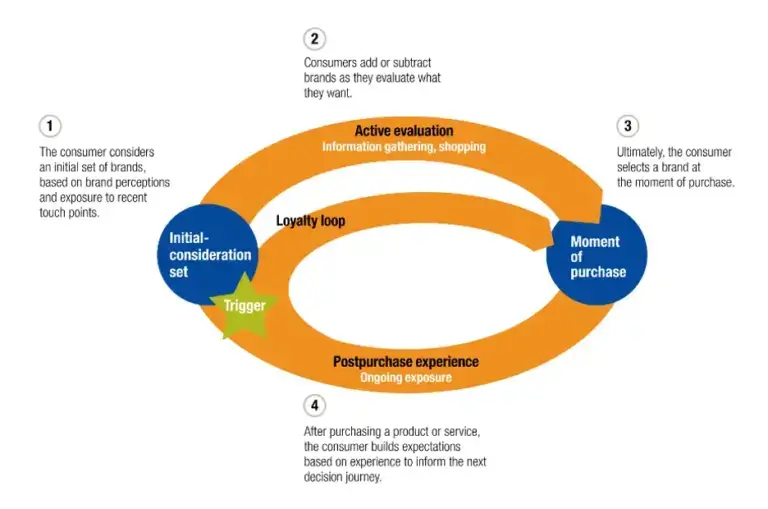
Image credit: McKinsey.com
In fact, the journey here is more of a spiral than a circle; it’s in that fourth, post-purchase stage where the decision journey becomes a ‘loyalty loop’ that can repeat itself forever. McKinsey puts forward the following roadmap for those latter stages:
- Purchasing: After initial consideration, the customer makes a purchase
- Experiencing: The customer forms opinions on the product or service
- Advocating: The customer spreads the word
- Bonding: The customer becomes a loyal customer who makes repeat purchases
Tools and processes for enhancing customer journeys
Understanding the modern customer journey and adapting to it are two very different things. Customers expect more than ever before from their brands in terms of personalization , relevance, and the ability to meet them where they are, on the channels they care about.
That means that customer experience and marketing teams need to employ processes that can make every touchpoint work harder. Usually, that means using a mix of surveys , customer experience analytics software , and behavioral data to finetune every channel and provide more powerful, personal and adaptable experiences.
Let’s take a look at some of the methods, tools and processes you can use to do exactly that, across three key areas:
1. Omnichannel engagement
Your customers are moving between channels and platforms in search of the information they need to make informed purchasing decisions. You need to be where they are.
Customer touchpoint analysis
Take stock of every touchpoint in which customers can interact with your brand. That’s everything from your website to your customer service portal, as well as TV ads, social media channels and third-party review sites.
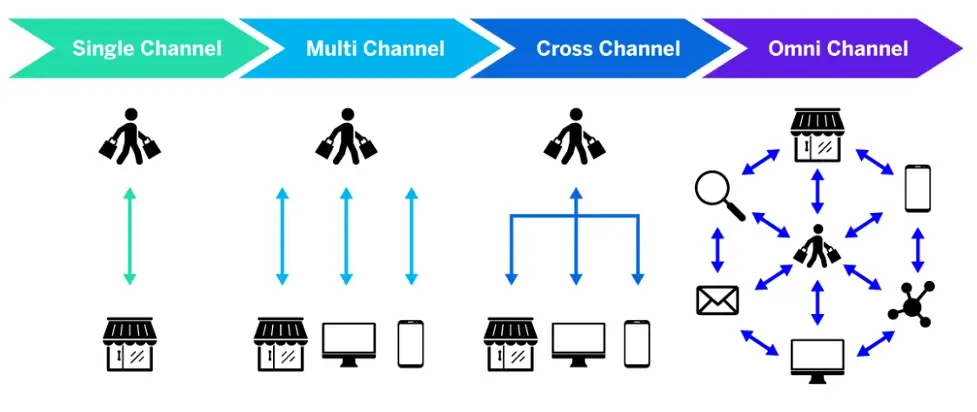
Your first step here is to lean into digital analytics to understand your share of voice, your conversion rate on call-to-action links, and anywhere you’re underrepresenting yourself. This stage is an audit, in effect – are you meeting people where they already are?
Omnichannel customer engagement
Once you understand every touch point, you need to think about how you can tie them together. Customers may jump from one touchpoint to the next in any order, so you need to be able to offer them a consistent experience that’s channel-agnostic.
That’s as important in marketing as it is in customer service – both rely on being able to track customer movements and proactively engage with people.
Customer journey optimization
Journey optimization starts with customer journey mapping exercises, in which you use customer data and your own insight to map out potential routes your customers take toward purchase. How can those journeys be tightened and streamlined? Hypothesize around this, make changes, and then test to see whether things improved.
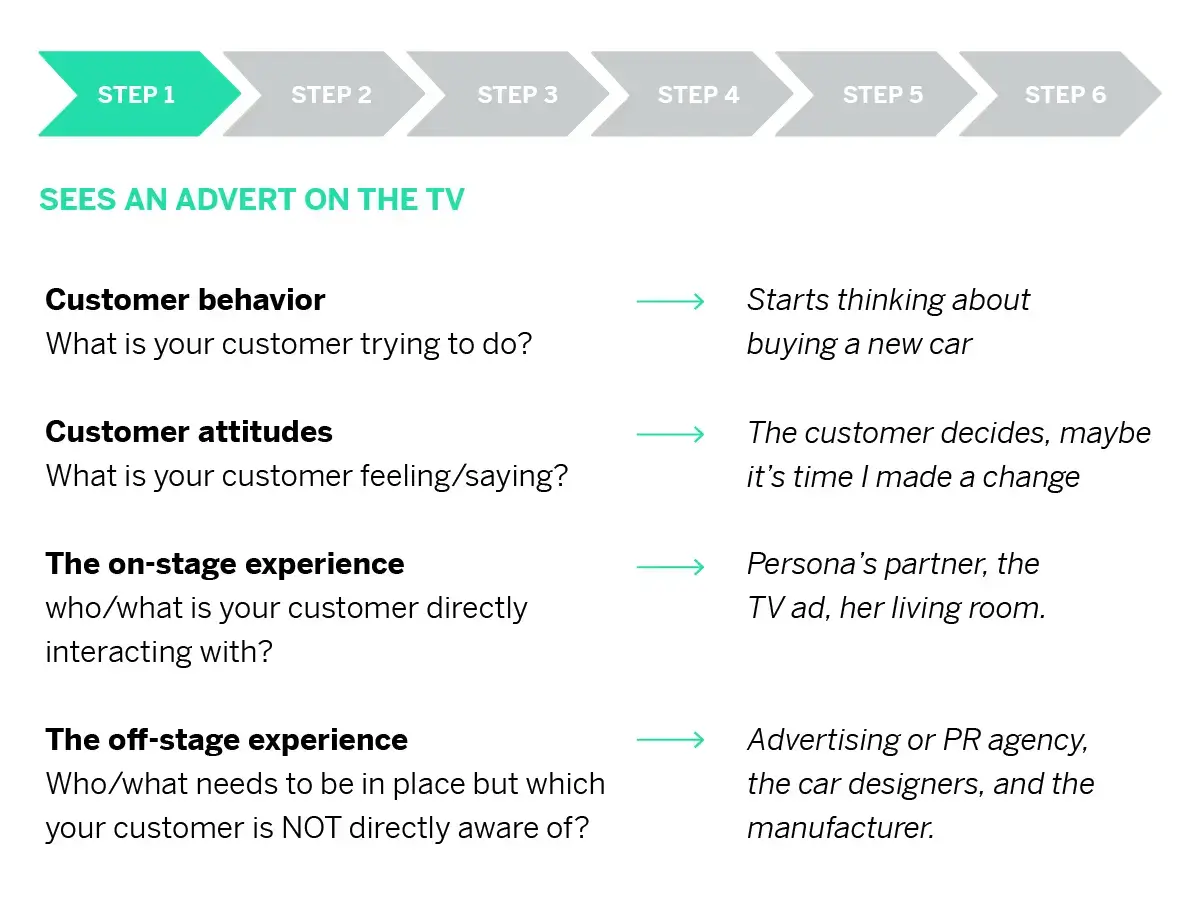

2. Behavioral analysis
How well do you understand what makes your customers tick? With the right software, you’ll be able to glean invaluable insights from the actions your customers do and don’t take.
Consumer behavior analysis
Understanding customer behavior allows you to adapt things to suit them – and identify where pain points and areas of friction lie. You’ll achieve this by using customer experience analytics suites capable of understanding behavioral heuristics.
These tools can identify patterns, show you how different audience segments act, and how purchasing decisions act as part of a wider whole.
Behavioral targeting strategies
Imagine if you knew that a specific customer always shops for a certain kind of product at certain times of the year, that they’re much more likely to make a purchase if there’s a discount with their name on it, or if bundling two items together will make them much more appealing than the sum of their parts.
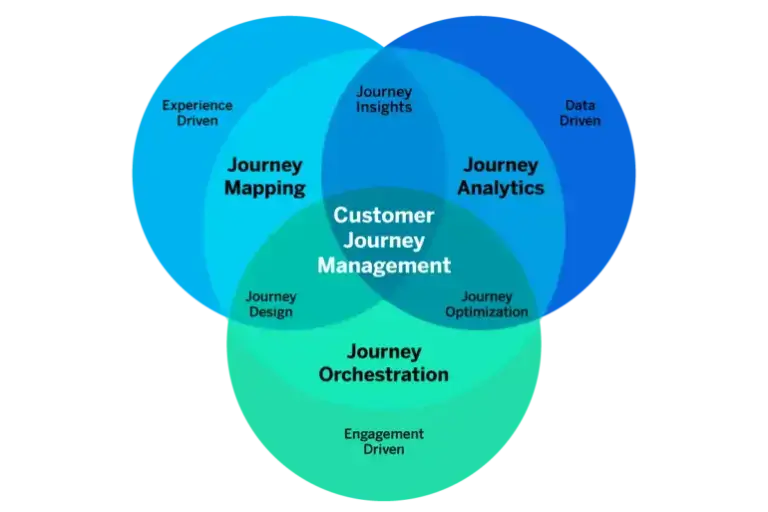
These are examples of behavioral targeting strategies that require a rock-solid understanding of each and every customer – and customer segment. Tools like Experience ID can help you gather that understanding, and tailor your efforts accordingly.
Refining the purchase decision process
It’s important to understand areas of your customer experience that are letting things down – and negatively impacting the customer buying process. If you can track customers as they move through your owned digital properties, you’ll have a clear idea of where people are dropping off, and why shopping carts are being left abandoned.
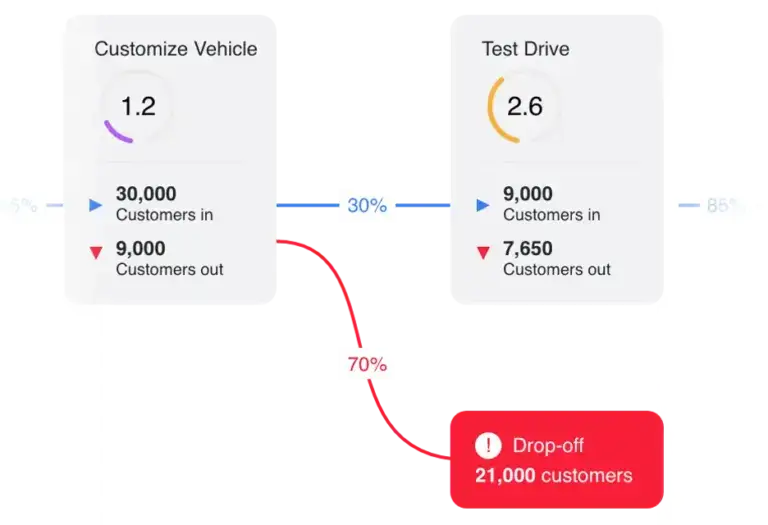
With that information, you can make proactive changes to the user experience in order to refine that initial consideration stage and better influence consumer purchasing behavior.
Learn more about customer behavior analysis
3. Postpurchase excellence
Once a customer has made a purchase, they’ll move into that inner ‘loyalty loop’ track of the consumer decision journey. This is your chance to wow them with postpurchase excellence – and generate real loyalty .
Customer experience analytics
Customer experience analytics is the process of collecting and analyzing customer data so that you can better understand customer needs, viewpoints, and experiences. This will help you to increase customer engagement and customer loyalty at every part of their journey – not just after making a purchase.
If you can understand the experience as it stands for existing customers, you’ll be able to direct your internal teams to take action on issues that are affecting satisfaction and loyalty.
Curating the customer engagement journey
Customer service is a huge part of postpurchase (repeat) purchase decisions. If a customer has had a positive customer support experience, they’re much more likely to buy from you again. So it’s important that this side of the customer experience is being monitored and managed.
Contact center management tools with AI and natural language processing can help here, by scanning and understanding every interaction every customer has with your business and proactively suggesting where things can be improved. That could be through trends that a bunch of different customers all mention, or by spotting opportunities for support agent coaching.
Customer lifecycle management
To keep customers coming back, you need to be able to keep a good eye on their behavior and ensure that if they have feedback, you’re able to close the loop by making the changes they want to see.
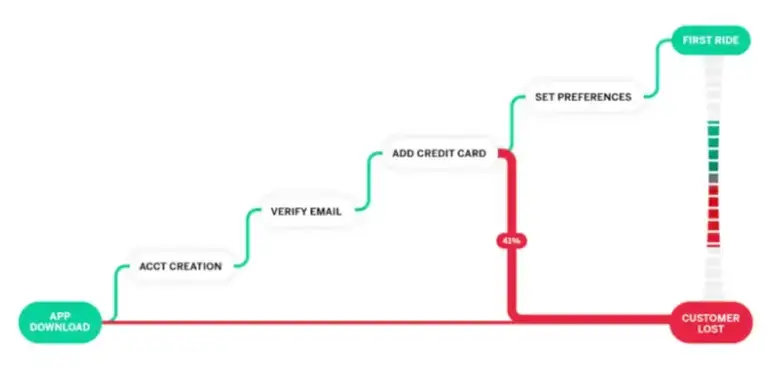
That’s alongside continually delighting them with proactive, personalized offers and communications. Keeping customers for the long haul means fostering a human-centric approach that uses software, surveys and analytics to help you show just how much you value their business.
Delivering customer-driven journeys
The consumer decision journey represents a complex, ever-evolving landscape that demands a really nuanced and adaptive approach from businesses. In an era where digital platforms dominate and consumer behaviors shift rapidly, understanding journeys from a scientific perspective is not just beneficial – it’s imperative for sustained success.
By embracing journey insights, businesses can position themselves at critical touchpoints, offering personalized solutions that resonate with consumers’ needs and preferences at the right moments. Integrating advanced analytics, omnichannel strategies and customer-centric thinking is what’ll help you exceed the expectations of today’s savvy consumers.
In other words? As you navigate this dynamic terrain, the key to unlocking customer loyalty and driving business growth lies in the ability to continuously adapt, innovate, and deliver exceptional experiences at every stage of the consumer decision journey.
Ready to transform your understanding of the consumer decision journey? With Qualtrics® Customer Journey Optimizer , you can take your customers where they want to go—in the fastest and most profitable way.
Elevate your customer journey management today
Related resources
Customer Journey
Customer Journey Orchestration 12 min read
Customer journey management 14 min read, customer journey stages 12 min read, buyer's journey 16 min read, customer journey analytics 13 min read, create journey map 24 min read, b2b customer journey 13 min read, request demo.
Ready to learn more about Qualtrics?
- SUGGESTED TOPICS
- The Magazine
- Newsletters
- Managing Yourself
- Managing Teams
- Work-life Balance
- The Big Idea
- Data & Visuals
- Reading Lists
- Case Selections
- HBR Learning
- Topic Feeds
- Account Settings
- Email Preferences
Data & Visuals

When making purchasing decisions, consumers go on a “consumer decision journey” comprised of four stages: consider a selection of brands; evaluate by seeking input from peers, reviewers, and others; buy; and enjoy, advocate, bond. This journey replaces the famous funnel metaphor.
Partner Center
Ten years on the consumer decision journey: Where are we today?
From left, Dave Elzinga, a partner, and Bo Finneman, an associate partner, both in the Marketing & Sales Practice, present new insights from the consumer decision journey at ad:tech New York in November. This wraps up a busy fall season of sharing these findings at events including Kellogg’s Marketing Leadership Summit in Chicago, the ECI Summit in Barcelona, and Forum McKinsey in São Paulo.
November 17, 2017 In the age of digital shopping—where the competitor is a click, swipe, or tap away—how consumers make purchase decisions has radically changed. Marketers have, therefore, become laser-focused on understanding what drives consumer decisions and influencing that journey.
McKinsey experts saw this growing need to better understand shifting consumer behavior nearly ten years ago, when we proposed a new approach called the consumer decision journey . It was a significant change in thinking that challenged the long-held concept of the sales funnel, where the decision path narrows in a linear way, from starting with awareness to ending with loyalty. The journey, instead, reflects a more complex reality of shifting choices, decision criteria, and triggers.
Today, after almost a decade, we have a database that covers more than 125,000 consumer decision journeys—used to help marketers influence consumers and drive growth—across 350 brands in 30 different industries. So, stepping back, the next big question our experts wanted to answer was how consumer behavior had changed over this time.
What did they find?
The bad news for brands is, Loyalty is now more elusive than ever, explains Bo Finneman , an associate partner in our Marketing & Sales Practice. Ninety percent of the categories the team studied showed no customer loyalty. And despite the explosion of loyalty programs, engagement in them is dropping.
With easy access to information today, consumers feel almost obligated to shop around, says Dave Elzinga, a partner also in our Marketing & Sales Practice. The proliferation of sophisticated sites and technologies has made it much easier for consumers to compare brands. And social media has created greater transparency into what influencers (for example, friends, family, celebrities) are buying and thinking, adds Bo. It’s continuously reminding consumers that multiple choices exist for a purchase, and the choices are constantly evolving, making each purchase cycle feel like new.
What I find remarkable is that so many people have more trust in what they read from total strangers than what companies tell them, says Dave. That shows us that brands need to win back the trust of consumers.
So what’s the good news? Every purchase is up for grabs today, says Dave. In fact, more than half of customers—58 percent—change brands from one purchase cycle to the next. While this has been seen as a challenge by marketers, it also greatly increases the number of opportunities for a brand to be considered.
And getting into the initial consideration set of brands early on in the decision-making process is critical. Nearly 70 percent of brand choices are made at this point—the beginning of the journey—when a consumer is first triggered to shop.
What we can see now based on our decision-journey data is the link between early consideration and a brand’s growth, explains Dave. This ultimately led to the creation of a new predictive metric this year—the customer growth indicator —that provides a simple score showing the growth potential of a product.
Once a brand knows its growth indicator score, it can easily compare itself to competitors and take effective action. If you’re at the bottom, you’ll want to innovate to make sure you can move up, says Dave. And if you’re at the top, you may need to reinforce your innovation and customer experience as a way of protecting your position. The growth indicator can help brands zero in on which customers to target for early consideration as well as determine how budgets are allocated across various marketing tactics.
The key takeaway: brands need to find ways to get into consumers’ consideration early and then continue to stay on the journey with them afterward when they’re triggered to make their next purchase. It used to be that you could win over a consumer and then gain loyalty for the longer term, says Bo. But today, consumers are more enamored with what’s new and continuously top of mind.
Never miss a story
This browser is no longer supported.
Upgrade to Microsoft Edge to take advantage of the latest features, security updates, and technical support.
- Contact Sales
- Try Azure for free
Azure Red Hat OpenShift April 2024 updates
Published date: april 10, 2024.
Azure Red Hat OpenShift (ARO) provides highly available, fully managed OpenShift clusters on demand, monitored and operated jointly by Microsoft and Red Hat.
The latest Azure Red Hat OpenShift update delivers the following enhancements:
- ARO support in Azure Terraform Provider: The AzureRM Terraform provider now supports managing Azure Red Hat Openshift resources. Hashicorp Terraform is an infrastructure-as-code tool that lets you define infrastructure resources in human-readable configuration files that can be versioned, reused and shared.
- Bring your own Network Security Groups: You can now attach your own NSGs that include both your organization’s security rules and ARO service rules. This will be applied to both master and worker subnets before installing ARO clusters with a flag indicating the presence of the NSGs.
- Azure Monitor Signals: You are able to provide ARO cluster Resource Health and integration with Azure Monitor Signals. Azure Monitor signals can be configured to generate alerts based on signals from Azure Red Hat OpenShift clusters. Learn more.
- New GPU instance types for Day 2 operations: Azure Red Hat OpenShift now supports new GPU instance types that are aimed at Day 2 operations. The following GPU instance types are now supported: ND96asr_v4, NC24ads_A100_v4,NC48ads_A100_v4, NC96ads_A100_v4,and ND96amsr_A100_v4. Learn more .
- ARO is now supported in the Taiwan Region: Azure Red Hat OpenShift is now supported in the Taiwan region providing more availability and fault tolerance to customers in this area. Learn more.
- Azure Red Hat OpenShift
Related Products

IMAGES
VIDEO
COMMENTS
Die Consumer Decision Journey ist demnach nicht-linear. Das bedeutet, dass die Phasen bis zur finalen Kaufentscheidung nicht nacheinander ablaufen, sondern sich oft überschneiden und wiederholen. Die CDJ hebt insbesondere die Bedeutung des Empfehlungsmarketings hervor, indem es Faktoren wie Kundenloyalität, Kundenbindung und die Erfahrungen ...
Aligning marketing with the consumer decision journey . Developing a deep knowledge of how consumers make decisions is the first step. For most marketers, the difficult part is focusing strategies and spending on the most influential touch points. In some cases, the marketing effort's direction must change, perhaps from focusing brand ...
Exhibit title: The consumer decision journey After purchasing a product or service, the consumer builds expectations based on experience to inform the next decision journey. Consumers add or subtract brands as they evaluate what they want. 1 3 4 2 The consumer considers an initial set of brands, based on brand perceptions and exposure to recent
Consumer Decision Journey. Das Modell wurde von McKinsey erstellt. Dieses Modell ist kein Funnel wie das AIDA-Modell, es beginnt mit der Überlegungsphase und endet mit der Kaufphase, es hat nur zwei Phasen und stellt nur einen Teil der Customer Journey dar. Nutzer:innen haben Bedürfnisse und suchen nach möglichen Lösungen, um diese ...
In 2009, we declared that the traditional "funnel" model—in which consumers began with a set number of brands in mind and whittled them down until they decided what to buy—had been usurped by what we called "the consumer decision journey." 1 This journey involved shoppers taking advantage of technology to evaluate products and ...
With Qualtrics® Customer Journey Optimizer, you can take your customers where they want to go—in the fastest and most profitable way. Elevate your customer journey management today. Free course. Gain valuable insights into the consumer decision journey and unleash the full potential of your marketing, customer support, and product initiatives.
The consumer decision journey model has become increasingly important to understand consumer decision-making processes. Although the term originally emerged with Court et al. in 2009, the various current perspectives of the consumer journey suggest the existence of distinct literature and theoretical roots that have yet to be fully explored in detail.
When making purchasing decisions, consumers go on a "consumer decision journey" comprised of four stages: consider a selection of brands; evaluate by seeking input from peers, reviewers, and ...
1 Identify the stages. The first step to apply the CDJ model is to identify the stages that your customers go through in their decision journey. The CDJ model consists of four main stages: initial ...
The Modern Consumer Decision Making Journey 7 Examining the Journey CONSIDERATION SETS The Consideration Set is a selection of goods, products, or services that customers consider as potential purchase options. Consideration Sets increase, decrease, fluctuate, or remain static in size throughout the journey as consumers assess, explore ...
McKinsey's consumer decision journey model helps you identify the moment of purchase, while the RACE Framework helps you build a strategy to get there. Use these customer journey models to win more customers. Based on empirical research, in 2009, McKinsey & Company suggested dramatic alternative customer journey models to the traditional ...
McKinsey partner David Edelman explains how companies can now shape the consumer decision journey.
The consumer decision journey model has become increasingly important to understand consumer decision-making processes. Although the term originally emerged with Court et al. in 2009, the various current perspectives of the consumer journey suggest the existence of distinct literature and theoretical roots that have yet to be fully explored in detail.
One part of the consumer decision journey (CDJ) turns out to be critical to driving the growth of a business: the initial consideration set of brands from which customers shop. In this episode of the McKinsey Podcast, McKinsey's Barr Seitz speaks with partner Dave Elzinga and partner Bo Finneman about this most important battleground for companies trying to win over customers and drive growth.
An effective way to reinforce a new belief is to focus on peak moments—specific parts of the consumer decision journey that have disproportionate impact and that consumers tend to remember most. Peak moments often include first-time experiences with a product or service, touchpoints at the end of a consumer journey (such as the checkout ...
The customer journey maps how a lead decides to buy a product or service. The decision-making process consists of multiple steps, from building awareness to conversion and loyalty. These stages aren't something every lead must go through; they just visualize the most common phases.
Consumer decision journey mapping. Built on consumer behaviour models from the 1960s and 1970s (e.g., Howard & Sheth, 1969), the consumer decision journey is the process that consumers go through, across all touchpoints and decision stages, that comprises the consumer experience (Lemon & Verhoef, 2016).
To create a customer journey map: 1. Decide what to measure-. Get clear on your goals, so you know what to look for as you plot your customer journey. 2. Create your customer persona-. Start with ...
Careful orchestration of the consumer decision journey is incredibly complex given the varying expectations, messages, and capabilities associated with each channel. According to published reports, 48 percent of US consumers believe companies need to do a better job of integrating their online and off-line experiences. There is a premium for ...
Sungevity's "product" is a seamless, personalized digital customer journey, based on innovative management of data about the solar potential of each home or business. Sungevity makes the journey so compelling that once customers encounter it, many never even consider competitors. One of us (David) experienced the Sungevity journey firsthand.
The steps of a consumer decision journey include: 1. Trigger: A stimulus or trigger begins the consumer decision journey when an individual notices they have a problem and need a company's product or service to resolve it. 2. Initial consideration set: When considering a purchase, an individual reflects on their initial consideration set, or ...
The journey, instead, reflects a more complex reality of shifting choices, decision criteria, and triggers. Today, after almost a decade, we have a database that covers more than 125,000 consumer decision journeys—used to help marketers influence consumers and drive growth—across 350 brands in 30 different industries.
Published date: April 10, 2024. Azure Red Hat OpenShift (ARO) provides highly available, fully managed OpenShift clusters on demand, monitored and operated jointly by Microsoft and Red Hat. The latest Azure Red Hat OpenShift update delivers the following enhancements: